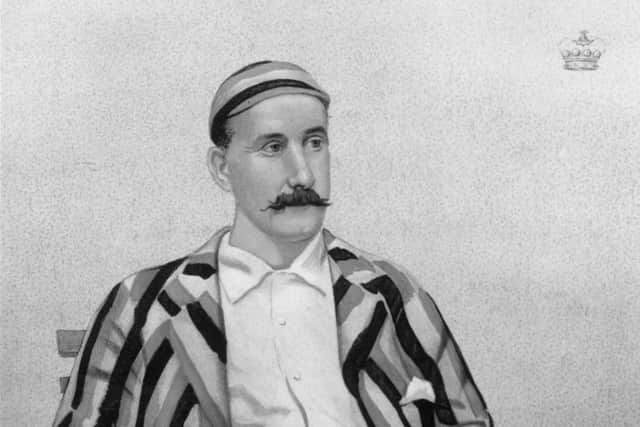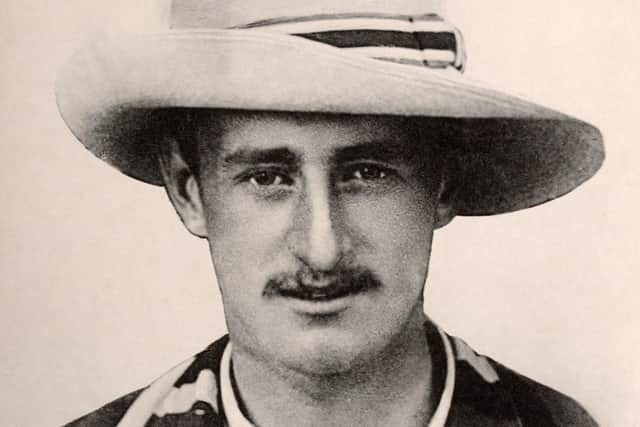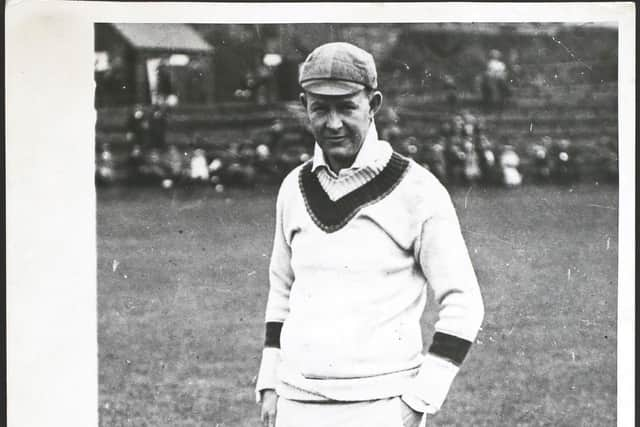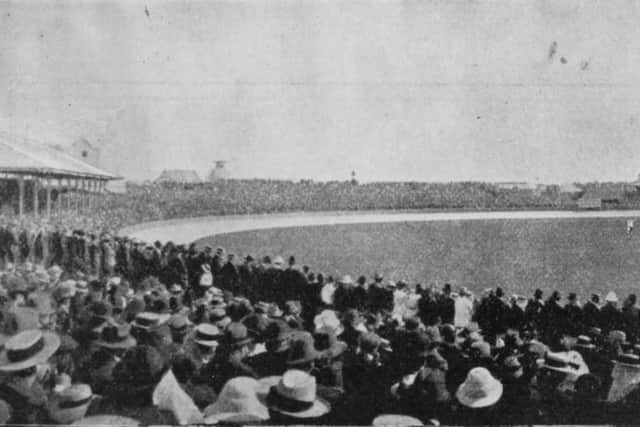Tip Foster: When married life agreed with one of the great figures from cricket's Golden Age
Tours were more relaxed and spread out back then, the voyage to Australia took several weeks by boat, and there was plenty of time to look around the sights and to drink in the scenes of a faraway land.
And so it was that Diana Foster found herself on a post-wedding trip with a difference following her marriage to one of England’s leading amateurs.
Advertisement
Hide AdAdvertisement
Hide AdR.E. ‘Tip’ Foster played only eight Test matches – including all five in that 1903-04 series – but he was one of the stars of the so-called Golden Age and, 120 years ago next Thursday, he achieved what remains the highest score by anybody on Test debut – 287 against Australia in Sydney.


Behind every good man is a good woman, so they say. Or, as Groucho Marx put it, “behind every successful man is a woman; behind her is his wife”.
Diana Foster came from successful stock herself; she was the second daughter of Charles Cammell, a Hull-born businessman who helped to found a famous steel manufacturing company in Sheffield.
The firm, which would become known as Charles Cammell and Company, soon expanded and merged into shipbuilding.
Advertisement
Hide AdAdvertisement
Hide AdThrough various evolutions, ups-and-downs and changes, the name lives on today in the form of Cammell Laird, the shipbuilding giant based in Birkenhead.


Married life seems to have agreed with ‘Tip’ Foster, a somewhat forgotten figure from cricket’s distant past.
Tall and thin, with angular features, he was born in Malvern in 1878 and his marriage to Diana was performed by his own father, the Reverend Henry Foster, a housemaster at Malvern College, ‘Tip’s’ alma mater.
Foster senior conducted the ceremony earlier in that year of 1903 at Huttons Ambo, near Malton, where the Cammells lived.
Advertisement
Hide AdAdvertisement
Hide AdHe must have been a proud father; ‘Tip’ was one of seven sons who played for Worcestershire, who were consequently known in those days as ‘Fostershire’ – cricket’s answer to astronomy’s ‘Seven Sisters’.


Foster got the nickname ‘Tip’ while studying at Oxford on account of his ‘tip-and-run’ style of batting.
He gained Blues in cricket, golf, football and racquets before graduating to a parallel career on the Stock Exchange, one which ate at his sportingcommitments.
Those commitments were considerable, for Diana Cammell had married not only a man who would go on to captain England in their 1907 home series against South Africa, but also one who captained England at football; in fact, Foster is the only man to have led England in both sports – something that might come in useful at a pub quiz. Foster, who played for Corinthians, a famous London amateur football club, led England in the last of his six internationals at inside-forward and, two years before striking his 287 in Sydney, shone in England’s first football match against Germany, scoring six times in a 12-0 victory.
Advertisement
Hide AdAdvertisement
Hide AdThat Foster would begin his Test career with a bang was perhaps therefore no surprise, although his selection for the 1903-04 Ashes tour was, in fact, criticised.


Not only was he uncapped but the 25-year-old had just one full season behind him due to his stockbroking duties, while his stylish batting – all supple wrists and graceful drives – was not deemed sufficiently durable for Australian conditions.
Archie MacLaren, another great batsman of the time, wrote prior to the tour that Foster was “not the type of batsman to succeed in Australia, where matches are won by steadiness rather thanbrilliancy”.
As if to show that today’s newspapers are indeed tomorrow’s fish-and-chip wrapper, Foster rammed MacLaren’s words back down his throat with his historic performance in the opening Test, one that remains the highest innings played for England in Australia.
Advertisement
Hide AdAdvertisement
Hide AdEngland, in fact, had been collectively written off prior to the tour; the squad led by ‘Plum’ Warner, the Middlesex batsman, was widely considered the weakest to have left these shores.
Warner, who was not even captain of his county team, somewhat fell into the role after Stanley Jackson, the Yorkshire all-rounder, turned it down because of “business, military and domestic commitments”, as you do...
Why don’t they make men like that anymore, incidentally?
However, the professional element of the squad was strong – not least in the form of the legendary Yorkshire pair George Hirst and Wilfred Rhodes, and the team in general had nothing to lose.
Australia, led by Monty Noble, a batsman of “rare style”, in the words of the Wisden almanack, chose to bat first at the Sydney Cricket Ground on a pitch which Warner remembered had “a brown, glazed look as if a hot iron had been passed over it and scorched the grass”.
Advertisement
Hide AdAdvertisement
Hide AdA big total was expected but Australia lost three wickets inside the first 20 minutes – Foster triggering the collapse with a brilliant slip catch – en route to a first innings score of 285 that owed much to Noble’s 133.
England were 73-3 in response when Foster began his historic innings on the second afternoon.
He was “scarcely at his best”, according to Warner, but battled through to reach 73 out of 243-4 stumps.
After a rest day, the game resumed on Monday December 14, 1903 on a pitch that had quickened in hot, sunny weather.
Advertisement
Hide AdAdvertisement
Hide AdThe change suited Foster, who used the pace of the ball and now positively plundered the bowling, racing first to his century, then his double century, on past Billy Murdoch’s record for the highest individual score in Test cricket at the time (211 for Australia against England at the Oval in 1884) before holing out to cover to end a last-wicket stand of 130 with Rhodes.
“He received a magnificent reception,” recalled Warner, following an innings that spanned seven hours and contained 37 fours, “and the cheering could not have been more genuine had it been at Lord’s or The Oval”.
Back home, people did not have to wait long for news of Foster’s heroics.
During this match, the Pacific cable company transmitted from the Sydney ground to the Central News Agency in London in the record time of three-and-a-half minutes – an “astonishing” achievement, in the view of Wisden.
Advertisement
Hide AdAdvertisement
Hide AdOne headline proclaimed: “Foster 287, Australia 285”, while another called him “R.E. (Record Extinguisher)Foster”.
The London Daily News declared: “No words of praise are too laudatory for the magnificent feat of R.E. Foster.
“The MCC have received a full vindication of their judgement in selectinghim.”
Foster’s innings helped England to 577 all-out, Australia replying with 485 in a second innings marred by a run-out controversy and subsequent crowd disturbances before England chased a target of 194 (Hirst 60 not out) to win by five wickets.
Advertisement
Hide AdAdvertisement
Hide AdIn the second Test in Melbourne, Foster retired ill on 49 complaining of a severe chill that developed into tonsillitis.
He was confined to bed for several days as wife Diana nursed him through his illness.
Although Foster returned for the third Test in Adelaide, he was never the same again in a series which England ran out 3-2 winners.
Poor health, in fact, dogged him from that moment on and he was to die tragically young at the age of 36, having contracted consumption (tuberculosis) following on from diabetes in the days before insulin could stabilise that condition.
Advertisement
Hide AdAdvertisement
Hide AdNews of Foster’s passing, in May 1914, reached Lord’s during Yorkshire’s game there against the MCC.
At MCC’s annual meeting the following year, Lord Hawke, the great Yorkshire potentate, paid tribute to a player who was admired as much for his gentleness of character as for his cricketing prowess.
“The early death of ‘Tip’ Foster was a great blow to the whole cricket world,” remarked Hawke.
“His 287 at Sydney will never be forgotten as long as cricket is played.”
Equally as touching was a gesture at Foster’s funeral.
Advertisement
Hide AdAdvertisement
Hide AdThere was standing room only as representatives from many sports and sporting bodies flocked to pay tribute.
Among some 150 floral tributes was a laurel wreath from Foster’s old captain, ‘Plum’ Warner, which said with poignant reference to the 287:
“To ‘Tip’, from ‘Plum’.
“Sydney, December 14, 1903.”
Comment Guidelines
National World encourages reader discussion on our stories. User feedback, insights and back-and-forth exchanges add a rich layer of context to reporting. Please review our Community Guidelines before commenting.